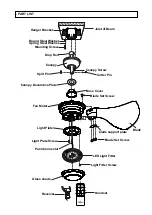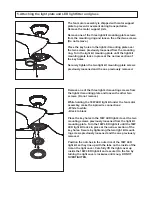
This product has been classed as Electrical or Electronic
Equipment and should not be disposed of with other
household or commercial waste at the end of it’s working life.
The Waste of Electrical and Electronic Equipment (WEEE)
Directive (2002/96/EC) has been put in place to recycle
products using best available precise and minimize the impact
upon the environment.
Having checked that all electrical connections are securely made and insulated, turn on the power
and check the operation of the fan.
The slide switch on the other side of the housing changes the direction of rotation of the blades.
(Remember to let the fan slow to a complete stop before changing the direction of rotation). When
looking up at the fan blades, anti –clockwise rotation achieves a downward flow of air and clockwise
rotation achieves an upward movement of air.
Summer operation – In warm weather a downward movement of air is more desirable as this achieves
a greater cooling effect.
Winter operation – In winter a movement of air moving upwards and then back down the sides of the
room achieves a more balanced temperature throughout the room.
If a wall control or remote control system has been used refer to the accompanying leaflets enclosed
in these systems.
Product Disposal Instructions
Operating instructions
Whilst every precaution is taken at the factory to ensure your fan is of the highest quality, imbalance
may occur. This may be due to slight irregularities in the blades or blade carriers. Deviating from
these instructions can cause further problems.
The following procedure may help to rectify the situation.
The hanging bracket must always be tight against the ceiling so that no movement can occur.
Make sure that the rod is firmly locked into the boss on top of the fan. The locking screw should be
securely tightened.
Check all the blades are firmly tightened on to their fixings.
Blade tracking can easily be checked by holding a yardstick or similar measure vertically from the
ceiling to the tip of the blade. Then check all blades measure the same distance from that point. To
correct slight problems re-check the screws that hold the blades onto the motor for tightness.
Changing over two adjacent blades – may correct any imbalance.
Use the universal balancing kit supplied with the fan.
Please note that drop rod styles of fans do have a slight level of movement but this is in no way
dangerous.
Blade balancing
Ensure that checks of the fixings take place periodically. (see Safety Precaution 11)
Periodic cleaning of your new fan is recommended particularly the blades. The plated or painted
surfaces of your fan have been sealed with a lacquer to minimize any discoloration or tarnishing.
Therefore use a soft brush or lint free cloth to avoid scratching the surface.
The motor has permanently sealed bearings so no lubrication is necessary
Do not use water when cleaning you fan as this could damage the surfaces of the casing and the
blades and may create the possibility of a electric shock.
Care and cleaning


































